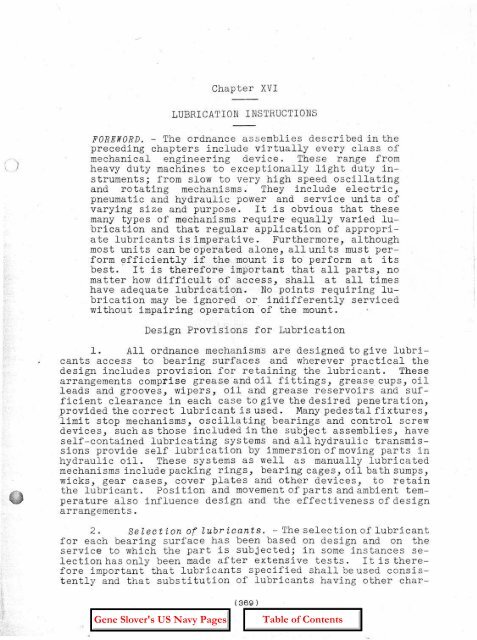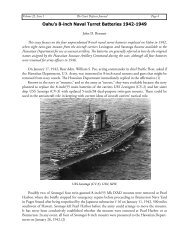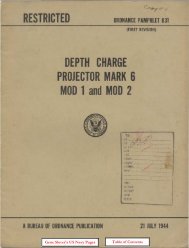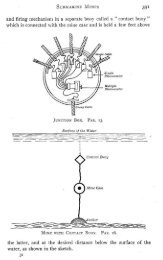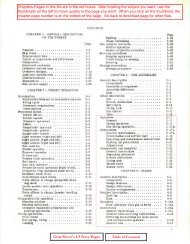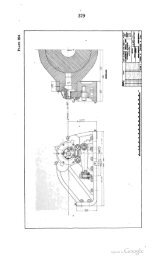OP-755 Part 2 Pages 197-401 - Personal Page of GENE SLOVER
OP-755 Part 2 Pages 197-401 - Personal Page of GENE SLOVER
OP-755 Part 2 Pages 197-401 - Personal Page of GENE SLOVER
You also want an ePaper? Increase the reach of your titles
YUMPU automatically turns print PDFs into web optimized ePapers that Google loves.
C)<br />
Chapter XVI<br />
LUBRICATIONINSTRUCTIONS<br />
FOREWORD. - The ordnance assemblies described in the<br />
preceding chapters include virtually every class <strong>of</strong><br />
mechanical engineering device. These range from<br />
heavy duty machines to exceptionally light duty instruments;<br />
from slQW to very high speed oscillating<br />
and rotating mechanisms: They include electric,<br />
pneumatic and hydraulic power and service uni ts <strong>of</strong><br />
varying size and purpose. It .is obvipus that these<br />
many types <strong>of</strong> mechanisms require equally varied lubrication<br />
and that regular application <strong>of</strong> appropriate<br />
lubricants is imperative. Furthermore, although<br />
most uni ts can beoper at ed alone, all uni ts must perform<br />
efficiently if the mount is to perform at its<br />
best. It is therefore important that all parts, no<br />
matter how difficult <strong>of</strong> access, shall at all times<br />
have adequate lubt~catiori. No points requiring lubrica<br />
tion may be ignored or indifferently serviced<br />
without impairing operation <strong>of</strong> the mount.<br />
Design Provisions for Lubrication<br />
1. All ordnance mechanisms are designed to give lubricants<br />
access to bearing surfaces and wherever practical the<br />
design includes provision for retaining the lubricant. These<br />
arrangements comprise grease and oilfi ttings, grease cups, oil<br />
leads and grooves, wipers, oil and grease reservoirs and sufficient<br />
clearance in each case to give the desired penetration,<br />
provided the correct lubricant is used. Manypedestal fixtures,<br />
1imit stop mechanisms, oscillating bearings and control screw<br />
devices, such as those included in the sub-ject assemblies, have<br />
self-·contained lubricating systems and all hydraulic transmissions<br />
provide self lubrication by immersion <strong>of</strong> moving parts in<br />
hydraulic oil. These systems as well as manually lubricated<br />
mechanisms include packing rings, bearing cages, oil bath sumps,<br />
wicks, gear cases, cover plates and other devices, to retain<br />
the lubricant. Position and movement<strong>of</strong> parts and ambient temperature<br />
also influence design and the effectiveness <strong>of</strong> design<br />
arrangements.<br />
2. Se lee t i on <strong>of</strong> Lubr i c an t s . - Theselec tion <strong>of</strong> lubricant<br />
for each bearing surface has been based on design and on the<br />
service to which the part is subjected; in some instances selection<br />
has only been made after extensive tes ts. It is therefore<br />
important that lubricants specified shall be used consi stently<br />
and that substitution <strong>of</strong> lubricants having other char-<br />
(359 )


